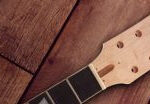The Emaj7 chord is a gateway to a richer, more nuanced world of guitar playing. Stepping beyond basic major and minor chords, the Emaj7, also known as E major seventh, introduces a sophisticated and jazzy flavor to your music. If you’re looking to expand your chord vocabulary and add depth to your playing, mastering the Emaj7 is a fantastic step forward.
This guide will break down everything you need to know about the Emaj7 chord on guitar. We’ll explore its construction, the notes it comprises, and, most importantly, how to play it in various positions across the fretboard. Whether you’re venturing into jazz, pop, or simply want to add a touch of elegance to your chord progressions, the Emaj7 is a chord you’ll want in your arsenal.
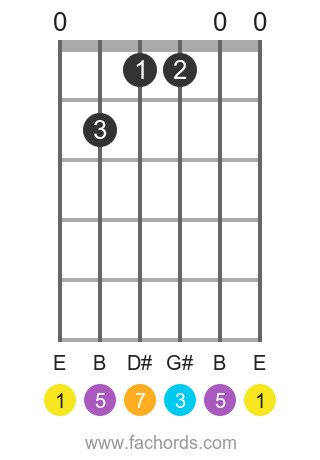 Diagram of the Emaj7 chord in open position 1, showcasing finger placement on the fretboard.
Diagram of the Emaj7 chord in open position 1, showcasing finger placement on the fretboard.
Understanding the Emaj7 Chord: Notes and Theory
At its heart, the Emaj7 chord is built upon the foundation of a standard E major chord, but with an added note that creates its distinctive sound. Let’s break down the musical theory:
- Root: E
- Major Third: G#
- Perfect Fifth: B
- Major Seventh: D#
These four notes – E, G#, B, and D# – are what constitute the Emaj7 chord. The “maj7” designation signifies the inclusion of the major seventh interval above the root. In terms of intervals from the root, the formula for a major seventh chord is: 1 (Root), 3 (Major Third), 5 (Perfect Fifth), and 7 (Major Seventh).
Understanding this formula isn’t just theoretical; it helps you visualize the chord’s construction across the fretboard and recognize its characteristic sound in different musical contexts. The major seventh interval adds a bright, lush, and slightly jazzy quality compared to a regular major chord.
Playing the Emaj7 Chord: Positions and Diagrams
Now, let’s get practical and explore how to play the Emaj7 chord in different positions on your guitar. We’ll use chord diagrams to illustrate finger placements for various voicings, ranging from open positions to barre chord shapes.
Position 1: Open Emaj7
This is often the first Emaj7 position guitarists learn due to its accessibility.
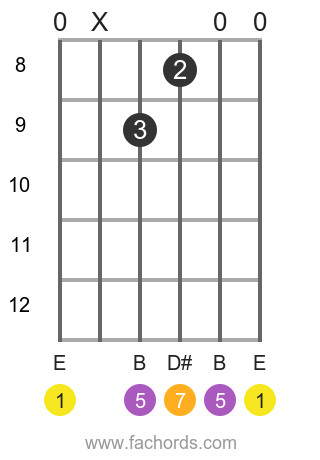 Chord diagram for the Emaj7 chord in open position 5, a movable shape.
Chord diagram for the Emaj7 chord in open position 5, a movable shape.
Position 2: Movable Shape
This Emaj7 position is a movable shape, meaning you can slide it up and down the neck to play other major 7th chords.
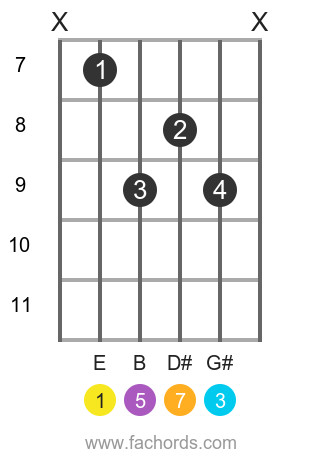 Chord diagram showing the Emaj7 chord in position 4, another movable form.
Chord diagram showing the Emaj7 chord in position 4, another movable form.
Position 3: Open Voicing
Another open position voicing, offering a slightly different sound and feel.
 Diagram of the Emaj7 chord in open position 1, showcasing finger placement on the fretboard.
Diagram of the Emaj7 chord in open position 1, showcasing finger placement on the fretboard.
Position 4: Open String Variation
This position incorporates open strings for a resonant Emaj7 sound.
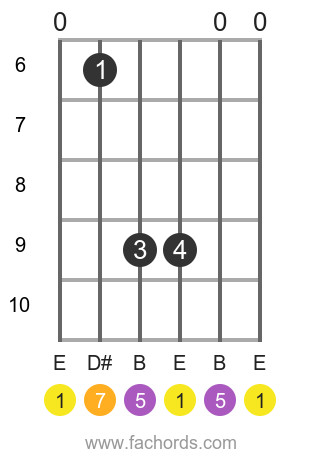 Chord chart for the Emaj7 chord in open position 6, highlighting open string usage.
Chord chart for the Emaj7 chord in open position 6, highlighting open string usage.
Position 5: Barre Chord Emaj7
A barre chord shape that is also movable, providing another versatile Emaj7 option.
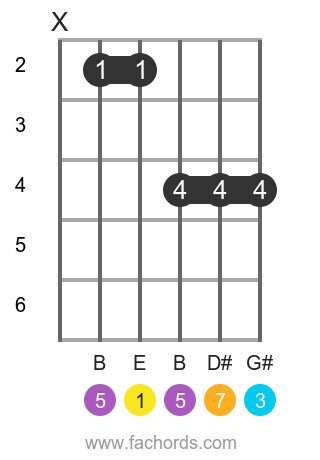 Emaj7 barre chord diagram in position 7, illustrating a common barre shape.
Emaj7 barre chord diagram in position 7, illustrating a common barre shape.
Position 6: Another Barre Shape
Another barre chord variation for the Emaj7, useful for different inversions and voicings.
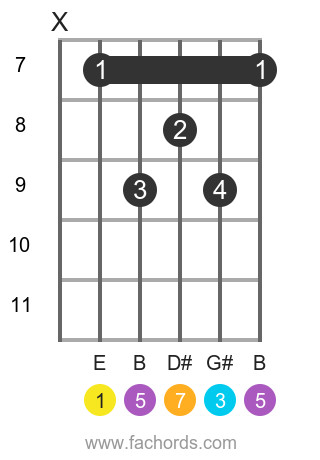 Chord diagram for Emaj7 barre chord in position 8, showcasing an alternative barre grip.
Chord diagram for Emaj7 barre chord in position 8, showcasing an alternative barre grip.
Position 7: Open Barre Hybrid
This position combines barre technique with open strings for a unique Emaj7 voicing.
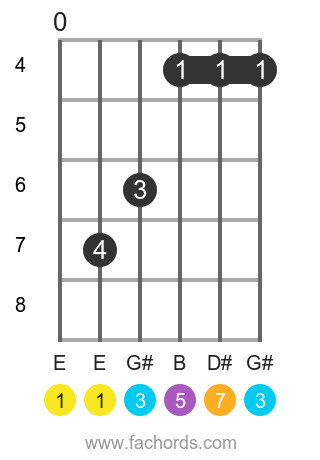 Emaj7 chord diagram in position 2, demonstrating an open barre hybrid shape.
Emaj7 chord diagram in position 2, demonstrating an open barre hybrid shape.
Position 8: Open Barre Variation
A final barre-based open position Emaj7, offering yet another sonic texture.
Remember to practice transitioning between these different Emaj7 positions to improve your fluidity and fretboard knowledge. Experiment with each voicing to discover which ones you prefer and how they fit into your playing style.
Incorporating the Emaj7 Chord into Your Music
The Emaj7 chord is incredibly versatile and can be used in various musical genres. Its sophisticated sound makes it a favorite in jazz, R&B, and pop music. Here are some ways to incorporate it:
- Chord Progressions: Try substituting the Emaj7 for a standard E major chord in common progressions to add harmonic interest. For example, a I-IV-V-I progression in E major (E-A-B-E) could become Emaj7-A-B-Emaj7.
- Jazz and Soul: The Emaj7 is a staple in jazz and soul music. Experiment with using it in 2-5-1 progressions or in vamps to create a smooth, jazzy feel.
- Pop Ballads: The lush quality of the Emaj7 can add emotional depth to pop ballads and softer songs.
By exploring these different positions and understanding its construction, you’ll be well on your way to mastering the Emaj7 chord and enriching your guitar playing. Keep practicing and experimenting, and you’ll soon find the Emaj7 becoming a valuable and beautiful addition to your musical vocabulary.

